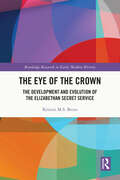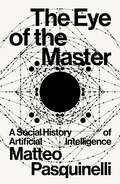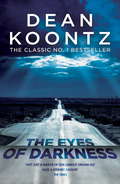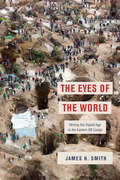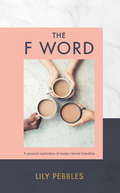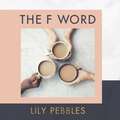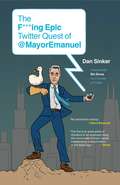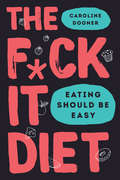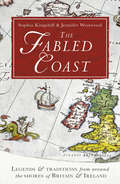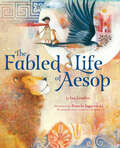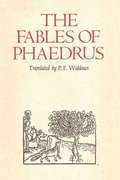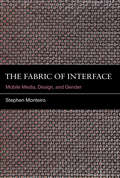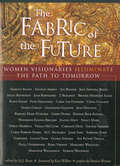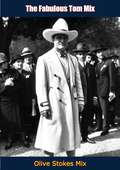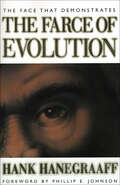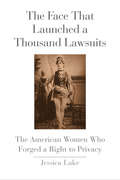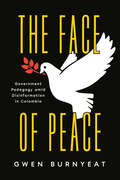- Table View
- List View
The Eye of Conscience: Photographers and Social Change
by Milton Meltzer Bernard ColePhotographs by noted photographers, past and present, and how photography has captured history and changed our existence.<P><P> Jane Addams Children’s Book Award Honor Book
The Eye of the Crown: The Development and Evolution of the Elizabethan Secret Service
by Kristin M.S. BezioThis volume discusses the development of governmental proto-bureaucracy, which led to and was influenced by the inclusion of professional agents and spies in the early modern English government. In the government’s attempts to control religious practices, wage war, and expand their mercantile reach both east and west, spies and agents became essential figures of empire, but their presence also fundamentally altered the old hierarchies of class and power. The job of the spy or agent required fluidity of role, the adoption of disguise and alias, and education, all elements that contributed to the ideological breakdown of social and class barriers. The volume argues that the inclusion of the lower classes (commoners, merchants, messengers, and couriers) in the machinery of government ultimately contributed to the creation of governmental proto-bureaucracy. The importance and significance of these spies is demonstrated through the use of statistical social network analysis, analyzing social network maps and statistics to discuss the prominence of particular figures within the network and the overall shape and dynamics of the evolving Elizabethan secret service. The Eye of the Crown is a useful resource for students and scholars interested in government, espionage, social hierarchy, and imperial power in Elizabethan England.
The Eye of the Master: A Social History of Artificial Intelligence
by Matteo PasquinelliA social history of AI that finally reveals its roots in the spatial computation of industrial factories and the surveillance of collective behaviour.What is AI? A dominant view describes it as the quest "to solve intelligence," a solution supposedly to be found in the secret logic of the mind or in the deep physiology of the brain, such as in its complex neural networks.The Eye of the Master argues, to the contrary, that the inner code of AI is shaped not by the imitation of biological intelligence, but the intelligence of labour and social relations, as it is found in Babbage's "calculating engines" of the industrial age as well as in the recent algorithms for image recognition and surveillance.The idea that AI may one day become autonomous (or "sentient", as someone thought of Google's LaMDA) is pure fantasy. Computer algorithms have always imitated the form of social relations and the organisation of labour in their own inner structure and their purpose remains blind automation.The Eye of the Master urges a new literacy on AI for scientists, journalists and new generations of activists, who should recognise that the "mystery" of AI is just the automation of labour at the highest degree, not intelligence per se.
The Eyes of Darkness: A gripping suspense thriller that predicted a global danger...
by Dean KoontzA search for a missing son... and a toxic mystery that threatens the globe. 'Did a 1981 Dean Koontz thriller predict the coronavirus outbreak?' Daily Mail'Dean Koontz is not just a master of our darkest dreams, but also a literary juggler' The TimesFrom bestselling phenomenon Dean Koontz, The Eyes of Darkness is a gripping thriller following a mother's search for her son - a journey that unlocks the deadliest of secrets. It's a year since Tina Evans lost her little boy Danny in a tragic accident. Then a shattering message appears on the blackboard in Danny's old room: NOT DEAD. Is it someone's idea of a grim joke? Or something far more sinister?The search for an answer drives Tina through the neon clamour of Las Vegas nightlife. The sun-scorched desert. The frozen mountains of the High Sierra. People face a dreadful danger as a buried truth struggles to surface. A truth so frightening that its secret must be kept at the price of any life - any man, any woman...any child. Why readers are obsessed with The Eyes of Darkness: 'Couldn't put it down...it's been a while since a book has kept me up all night.' ***** Goodreads review'So prophetic I really can't believe it.' ***** Goodreads review'It is simply unbelievable.' ***** Goodreads reviewThis book was originally published under the pseudonym Leigh Nichols.
The Eyes of the World: Mining the Digital Age in the Eastern DR Congo
by James H. SmithThe Eyes of the World focuses on the lives and experiences of Eastern Congolese people involved in extracting and transporting the minerals needed for digital devices. The digital devices that, many would argue, define this era exist not only because of Silicon Valley innovations but also because of a burgeoning trade in dense, artisanally mined substances like tantalum, tin, and tungsten. In the tentatively postwar Eastern DR Congo, where many lives have been reoriented around artisanal mining, these minerals are socially dense, fueling movement and innovative collaborations that encompass diverse actors, geographies, temporalities, and dimensions. Focusing on the miners and traders of some of these “digital minerals,” The Eyes of the World examines how Eastern Congolese understand the work in which they are engaged, the forces pitted against them, and the complicated process through which substances in the earth and forest are converted into commodified resources. Smith shows how violent dispossession has fueled a bottom-up social theory that valorizes movement and collaboration—one that directly confronts both private mining companies and the tracking initiatives implemented by international companies aspiring to ensure that the minerals in digital devices are purified of blood.
The F Word: A personal exploration of modern female friendship
by Lily PebblesIf there's one piece of invaluable advice for women and girls of all ages, it is that there is nothing more important than creating and maintaining strong, positive and happy friendships with other women.In a culture that largely pits women against each other, I want to celebrate female friendships... all strings attached!If my 1998 diary is anything to go by, female friendships are incredibly complex and emotional but they're the mini love stories that make us who we are. For many women, friends are our partners in crime through life; they are the ones who move us into new homes, out of bad relationships, through births and illnesses. In The F Word I've set out to explore and celebrate the essence of female friendship at different life stages and in its many wild and wonderful forms.
The F Word: A personal exploration of modern female friendship
by Lily PebblesIf there's one piece of invaluable advice for women and girls of all ages, it is that there is nothing more important than creating and maintaining strong, positive and happy friendships with other women.In a culture that largely pits women against each other, I want to celebrate female friendships... all strings attached!If my 1998 diary is anything to go by, female friendships are incredibly complex and emotional but they're the mini love stories that make us who we are. For many women, friends are our partners in crime through life; they are the ones who move us into new homes, out of bad relationships, through births and illnesses. In The F Word I've set out to explore and celebrate the essence of female friendship at different life stages and in its many wild and wonderful forms.
The F Word: A personal exploration of modern female friendship
by Lily PebblesA personal celebration of female friendships - the good, the bad and the complicated - by lifestyle content creator, Lily Pebbles.If there's one piece of invaluable advice for women and girls of all ages, it is that there is nothing more important than creating and maintaining strong, positive and happy friendships with other women.In a culture that largely pits women against each other, I want to celebrate female friendships... all strings attached!If my 1998 diary is anything to go by, female friendships are incredibly complex and emotional but they're the mini love stories that make us who we are. For many women, friends are our partners in crime through life; they are the ones who move us into new homes, out of bad relationships, through births and illnesses. In The F Word I've set out to explore and celebrate the essence of female friendship at different life stages and in its many wild and wonderful forms.(P)2018 Hodder & Stoughton Limited
The F***ing Epic Twitter Quest of @MayorEmanuel
by Dan Sinker Biz StonePrimary Colors for the social media era, the wildly profane, viral phenomenon that resulted from a fake Twitter account deftly satirizing Rahm Emanuel is the first significant Twitter epic in today's digital age. Primary Colors for the social media era, the wildly profane, viral phenomenon that resulted from a fake Twitter account deftly satirizing Rahm Emanuel is the first significant Twitter epic in today's digital age. With web sensations such as Stuff White People Like and Sh*t My Dad Says making the leap from the Internet to the bestseller lists, it's no surprise that this unique and hilarious first-person account of Rahm Emanuel's fake mayoral campaign via Twitter has already been featured in The Atlantic, Wired, The Colbert Report, and is still an unfolding story. Now, fans can read the entire six months of collected tweets of @MayorEmanuel with commentary and annotations from creator Dan Sinker. When rumors circulated that Rahm Emanuel would enter the Chicago mayor's race, suddenly the "real" Rahm became overshadowed by a decidedly different Rahm, @MayorEmanuel. Via Twitter, this fake Rahm spun a faux-insider's story unlike any other--in real time. Garnering a passionate following on Twitter and hailed by the press, @MayorEmanuel's journey is an entertaining, modern-day anti-hero's quest as he travels a surrealistic Chicago landscape, picking up friends along the way, including advisor David Axelrod, Carl the Intern (a high-school-aged MacGyver), a puppy named Hambone, and a duck named Quaxelrod, to name a few. Both a surprisingly literary romp as well as an inside peek into an historic mayoral race, The F***ing Epic Twitter Quest of @MayorEmanuel is a bold and exciting foray into a new form of participatory, real-time storytelling.
The F*ck It Diet: Eating Should Be Easy
by Caroline Dooner“The F*ck It Diet is not only hilarious, it is scientifically and medically sound. A must read for any chronic dieter.” –Christiane Northrup, MD, New York Times bestselling author of Women’s Bodies, Women’s Wisdom” From comedian and ex-diet junkie Caroline Dooner, an inspirational guide that will help you stop dieting, reboot your relationship with food, and regain your personal powerDIETING DOESN’T WORKNot long term. In fact, our bodies are hardwired against it. But each time our diets fail, instead of considering that maybe our ridiculously low-carb diet is the problem, we wonder what’s wrong with us. Why can’t we stick to our simple plan of grapefruit and tuna fish??? Why are we so hungry? What is wrong with us??? We berate ourselves for being lazy and weak, double down on our belief that losing weight is the key to our everlasting happiness, and resolve to do better tomorrow. But it’s time we called a spade a spade: Constantly trying to eat the smallest amount possible is a miserable way to live, and it isn’t even working. So fuck eating like that. In The F*ck It Diet, Caroline Dooner tackles the inherent flaws of dieting and diet culture, and offers readers a counterintuitively simple path to healing their physical, emotional, and mental relationship with food. What’s the secret anti-diet? Eat. Whatever you want. Honor your appetite and listen to your hunger. Trust that your body knows what it is doing. Oh, and don’t forget to rest, breathe, and be kind to yourself while you’re at it. Once you get yourself out of survival mode, it will become easier and easier to eat what your body really needs—a healthier relationship with food ultimately leads to a healthier you. An ex-yo-yo dieter herself, Dooner knows how terrifying it can be to break free of the vicious cycle, but with her signature sharp humor and compassion, she shows readers that a sustainable, easy relationship with food is possible. Irreverent and empowering, The F*ck It Diet is call to arms for anyone who feels guilt or pain over food, weight, or their body. It’s time to give up the shame and start thriving. Welcome to the F*ck It Diet. Let’s Eat.
The Fable of the Bees
by Bernard Mandeville Phillip HarthA physician with a particular interest in psychological disorders and satirist, Mandeville published versions of his notorious Fable of the Bees from 1714 to 1732. Each was a defence and elaboration of his short satirical poem The Angry Hive, 1705. The version of the Fable of 1723 and 1732 are the fullest defences of his early paradox that social benefit is the unintended consequence of personal vice. It is an argument that is generally held to lie behind Adam Smith's doctrine of the 'hidden hand' of economic development.
The Fabled Coast: Legends & traditions from around the shores of Britain & Ireland
by Sophia Kingshill Jennifer Beatrice WestwoodPirates and smugglers, ghost ships and sea-serpents, fishermen’s prayers and sailors’ rituals – the coastline of the British Isles plays host to an astonishingly rich variety of local legends, customs, and superstitions.In The Fabled Coast, renowned folklorists Sophia Kingshill and Jennifer Westwood gather together the most enthralling tales and traditions, tracing their origins and examining the facts behind the legends. Was there ever such a beast as the monstrous Kraken? Did a Welsh prince discover America, centuries before Columbus? What happened to the missing crew of the Mary Celeste? Along the way, they recount the stories that are an integral part of our coastal heritage, such as the tale of Drake’s Drum, said to be heard when England was in peril, and the mythical island of Hy Brazil, which for centuries appeared on sea charts and maps to the west of Ireland. The result is an endlessly fascinating, often surprising journey through our island history.
The Fabled Life of Aesop: The extraordinary journey and collected tales of the world's greatest storyteller
by Ian Lendler★ &“Lovely art comes with unusual perspectives on familiar tales about lions, mice and trickster foxes.&” —Kirkus, starred review &“Many children are familiar with Aesop&’s fables but it is a fair bet that few know much about the storyteller himself…(a) beautiful volume.&” —Wall Street JournalHonoring the path of a slave, this dramatic picture-book biography and concise anthology of Aesop&’s most child-friendly fables tells how a child born into slavery in ancient Greece found a way to speak out against injustice by using the skill and wit of his storytelling—storytelling that has survived for 2,500 years. Stunningly illustrated by two-time Caldecott Honor winner Pamela Zagarenski. The Tortoise and the Hare. The Boy Who Cried Wolf. The Fox and the Crow. Each of Aesop&’s stories has a lesson to tell, but Aesop&’s life story is perhaps the most inspiring tale of them all. Gracefully revealing the genesis of his tales, this story of Aesop shows how fables not only liberated him from captivity but spread wisdom over a millennium. This is the only children&’s book biography about him. Includes thirteen illustrated fables: The Lion and the Mouse, The Goose and the Golden Egg, The Fox and the Crow, Town Mouse and Country Mouse, The Ant and the Grasshopper, The Dog and the Wolf, The Lion and the Statue, The Tortoise and the Hare, The Boy Who Cried Wolf, The North Wind and the Sun, The Fox and the Grapes, The Dog and the Wolf, The Lion and the Boar.
The Fables of Phaedrus
by Phaedrus translated by P. F. WiddowsAnimal fables are said to have originated with Aesop, a semilegendary Samian slave, but the earliest surviving record of the fables comes from the Latin poet Phaedrus, who introduced the new genre to Latin literature. This verse translation of The Fables is the first in English in more than two hundred years. In addition to the familiar animal fables, about a quarter of the book includes such diverse material as prologues and epilogues, historical anecdotes, short stories, enlarged proverbs and sayings, comic episodes and folk wisdom, and many incidental glimpses of Greek and Roman life in the classical period. The Fables also sheds light on the personal history of Phaedrus, who seems to have been an educated slave, eventually granted his freedom by the emperor Augustus. Phaedrus' style is lively, clean, and sparse, though not at the cost of all detail and elaboration. It serves well as a vehicle for his two avowed purposes-to entertain and to give wise counsel for the conduct of life. Like all fabulists, Phaedrus was a moralist, albeit on a modest and popular level. An excellent introduction by P. F. Widdows provides information about Phaedrus, the history of The Fables, the metric style of the original and of this translation, and something of the place of these fables in Western folklore. The translation is done in a free version of Anglo-Saxon alliterative verse, a form used by W. H. Auden and chosen here to match the popular tone of Phaedrus' Latin verse.
The Fabric of Civil War Society: Uniforms, Badges, and Flags, 1859–1939 (Conflicting Worlds: New Dimensions of the American Civil War)
by Shae Smith CoxMilitary uniforms, badges, flags, and other material objects have been used to represent the identity of Americans throughout history. In The Fabric of Civil War Society, Shae Smith Cox examines the material culture of America’s bloodiest conflict, offering a deeper understanding of the war and its commemoration.Cox’s analysis traces the influence of sewn materials throughout the Civil War and Reconstruction as markers of power and authority for both the Union and the Confederacy. These textiles became cherished objects by the turn of the century, a transition seen in veterans replacing wartime uniforms with new commemorative attire and repatriating Confederate battle flags. Looking specifically at the creation of material culture by various commemoration groups, including the Grand Army of the Republic, the Woman’s Relief Corps, the United Confederate Veterans, and the United Daughters of the Confederacy, Cox reveals the ways that American society largely accepted their messages, furthering the mission of their memory work.Through the lens of material culture, Cox sheds new light on a variety of Civil War topics, including preparation for war, nuances in relationships between Native American and African American soldiers, the roles of women, and the rise of postwar memorial societies.
The Fabric of Cultures: Fashion, Identity, and Globalization
by Eugenia Paulicelli Hazel ClarkFashion is both public and private, material and symbolic, always caught within the lived experience and providing an incredible tool to study culture and history. The Fabric of Cultures examines the impact of fashion as a manufacturing industry and as a culture industry that shapes the identities of nations and cities in a cross-cultural perspective, within a global framework. The collected essays investigate local and global economies, cultures and identities and the book offers for the first time, a wide spectrum of case studies which focus on a diversity of geographical spaces and places, from global capitals of fashion such as New York, to countries less known or identifiable for fashion such as contemporary Greece and soviet Russia. Highly illustrated and including essays from all over the world, The Fabric of Cultures provides a comprehensive survey of the latest interdisciplinary scholarship on fashion, identity and globalisation.
The Fabric of Interface: Mobile Media, Design, and Gender (The\mit Press Ser.)
by Stephen MonteiroTracing the genealogy of our physical interaction with mobile devices back to textile and needlecraft culture. For many of our interactions with digital media, we do not sit at a keyboard but hold a mobile device in our hands. We turn and tilt and stroke and tap, and through these physical interactions with an object we make things: images, links, sites, networks. In The Fabric of Interface, Stephen Monteiro argues that our everyday digital practice has taken on traits common to textile and needlecraft culture. Our smart phones and tablets use some of the same skills—manual dexterity, pattern making, and linking—required by the handloom, the needlepoint hoop, and the lap-sized quilting frame. Monteiro goes on to argue that the capacity of textile metaphors to describe computing (weaving code, threaded discussions, zipped files, software patches, switch fabrics) represents deeper connections between digital communication and what has been called “homecraft” or “women's work.” Connecting networked media to practices that seem alien to media technologies, Monteiro identifies handicraft and textile techniques in the production of software and hardware, and cites the punched cards that were read by a loom's rods as a primitive form of computer memory; examines textual and visual discourses that position the digital image as a malleable fabric across its production, access, and use; compares the digital labor of liking, linking, and tagging to such earlier forms of collective production as quilting bees and piecework; and describes how the convergence of intimacy and handiwork at the screen interface, combined with needlecraft aesthetics, genders networked culture and activities in unexpected ways.
The Fabric of the Future: Women Visionaries Illuminate the Path to Tomorrow
by M. J. RyanWith contributions from Gloria Steinem, Nancy Mairs, Marianne Williamson, and other forward-looking women, “there is plenty of wisdom in these pages” (Publishers Weekly).This collection includes essays by women—from psychologists to activists to artists—who represent a wide range of philosophies, religions, spiritualities, and ethnicities, but share the goal of creating a new age of transformation. Surveying the cultural landscape, they offer their insights into how we can navigate from chaos to clarity—and help create a better tomorrow.Contributors include: Joan Borysenko * Brooke Medicine Eagle * Shakti Gawain * Starhawk * Gloria Steinem * Jean Houston * Marianne Williamson * Caroline Myss * Angeles Arrien * Vimala McClure * Marion Woodman * Jean Shinoda Bolen * Joanna Macy * and many more“A timeless book . . . filled with wisdom both feminine and universal.” —Dan Millman, author of Way of the Peaceful Warrior“Much trenchant thinking and many healing ideas.” —Yoga Journal“It is impossible to read this book and not be glad that you were born a woman.” —Rachel Naomi Remen, MD, New York Times-bestselling author of Kitchen Table Wisdom
The Fabulous Tom Mix
by Olive Stokes Mix Eric HeathAn excellent firsthand account of the famed cowboy movie star.Tom Mix (1880–1940) was an American motion picture actor, director, and writer whose career spanned from 1910 to 1935. During this time he appeared in 270 films and established himself as the screen's most popular cowboy star. Mix's flair for showmanship set the standard for later cowboy heroes such as Gene Autry and Roy Rogers. His horse Tony also became a celebrity who received his own fan mail.
The Face That Demonstrates the Farce of Evolution
by Hank HanegraaffLooking into the face of our alleged ape ancestor, popular Christian apologist Hank Hanegraaff dissects and debunks the astonishingly weak arguments for the evolutionary theory, revealing it as nothing more than a "fairy tale for grown-ups." The author uses his own Memory Dynamics to make it easy for Christians to speak intelligently about evolution and speak persuasively about the Creator.
The Face That Launched a Thousand Lawsuits: The American Women Who Forged a Right to Privacy
by Jessica LakeA compelling account of how women shaped the common law right to privacy during the late nineteenth and early twentieth centuries Drawing on a wealth of original research, Jessica Lake documents how the advent of photography and cinema drove women--whose images were being taken and circulated without their consent--to court. There they championed the creation of new laws and laid the groundwork for America's commitment to privacy. Vivid and engagingly written, this powerful work will draw scholars and students from a range of fields, including law, women's history, the history of photography, and cinema and media studies.
The Face of Eastern European Jewry
by Arnold ZweigThis work brings together the impassioned writing of one of Weimar Germany's most celebrated authors, Arnold Zweig, and the equally poignant illustrations by renowned graphic artist and lithographer Hermann Struck.
The Face of Peace: Government Pedagogy amid Disinformation in Colombia
by Gwen BurnyeatA multi-scale ethnography of government pedagogy in Colombia and its impact on peace. Colombia’s 2016 peace agreement with the FARC guerrillas sought to end fifty years of war and won President Juan Manuel Santos the Nobel Peace Prize. Yet Colombian society rejected it in a polarizing referendum, amid an emotive disinformation campaign. Gwen Burnyeat joined the Office of the High Commissioner for Peace, the government institution responsible for peace negotiations, to observe and participate in an innovative “peace pedagogy” strategy to explain the agreement to Colombian society. Burnyeat’s multi-scale ethnography reveals the challenges government officials experienced communicating with skeptical audiences and translating the peace process for public opinion. She argues that the fatal flaw in the peace process lay in government-society relations, enmeshed in culturally liberal logics and shaped by the politics of international donors. The Face of Peace offers the Colombian case as a mirror to the global crisis of liberalism, shattering the fantasy of rationality that haunts liberal responses to “post-truth” politics.
The Face of Peace: Government Pedagogy amid Disinformation in Colombia
by Gwen BurnyeatA multi-scale ethnography of government pedagogy in Colombia and its impact on peace. Colombia’s 2016 peace agreement with the FARC guerrillas sought to end fifty years of war and won President Juan Manuel Santos the Nobel Peace Prize. Yet Colombian society rejected it in a polarizing referendum, amid an emotive disinformation campaign. Gwen Burnyeat joined the Office of the High Commissioner for Peace, the government institution responsible for peace negotiations, to observe and participate in an innovative “peace pedagogy” strategy to explain the agreement to Colombian society. Burnyeat’s multi-scale ethnography reveals the challenges government officials experienced communicating with skeptical audiences and translating the peace process for public opinion. She argues that the fatal flaw in the peace process lay in government-society relations, enmeshed in culturally liberal logics and shaped by the politics of international donors. The Face of Peace offers the Colombian case as a mirror to the global crisis of liberalism, shattering the fantasy of rationality that haunts liberal responses to “post-truth” politics.
The Face of Peace: Government Pedagogy amid Disinformation in Colombia
by Gwen BurnyeatA multi-scale ethnography of government pedagogy in Colombia and its impact on peace. Colombia’s 2016 peace agreement with the FARC guerrillas sought to end fifty years of war and won President Juan Manuel Santos the Nobel Peace Prize. Yet Colombian society rejected it in a polarizing referendum, amid an emotive disinformation campaign. Gwen Burnyeat joined the Office of the High Commissioner for Peace, the government institution responsible for peace negotiations, to observe and participate in an innovative “peace pedagogy” strategy to explain the agreement to Colombian society. Burnyeat’s multi-scale ethnography reveals the challenges government officials experienced communicating with skeptical audiences and translating the peace process for public opinion. She argues that the fatal flaw in the peace process lay in government-society relations, enmeshed in culturally liberal logics and shaped by the politics of international donors. The Face of Peace offers the Colombian case as a mirror to the global crisis of liberalism, shattering the fantasy of rationality that haunts liberal responses to “post-truth” politics.

